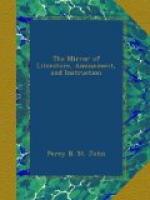The population of the county of Glamorgan, in 1821, comprised 101,727 persons.
To return to Gower. The first English or Norman conqueror of this lordship was Henry de Newburgh, Earl of Warwick, who, in the reign of Henry I. (1099), progressively defeated and drove out the sons of Caradoc ap Jestyn, the Welsh possessors of Gower; and to secure his conquest, built the castles of Swansea, Loughor, Llanridian, Penrice, &c. He is represented, like most of the feudal barons, as ruling with an iron hand. A few years after this conquest (1108), the peninsula was settled by a colony of Flemings, who had been obliged to emigrate, in consequence of a disastrous encroachment of the sea in the Low Countries. They first landed on the southern coast of England; but, on account of their lawless conduct, Henry I. drove them into South Wales; and they principally fixed themselves in Gower, where they became peaceable subjects; though a great number settled in the peninsula of Castle Martin, in Pembrokeshire, which bears a striking similarity in its natural features to Gower. Afterwards they mixed with the English, preserving their native manners and industry, and involved in disputes with the Welsh resembling the ancient Border warfare in the North. To this day the inhabitants of Gower are distinct from the Welsh, and all speak the English language. We were informed, and it is a remarkable fact, that in the south-western portion of Gower, some of the descendants of the original colonists exist, who do not understand the Welsh language, rarely intermarry with them, and are otherwise distinguished by their dress and peculiar dialect. These people, who have thus successively, for more than seven centuries, preserved almost unmingled the manners of their progenitors, manufacture lace of the same fabric as that of Flanders. In the reign of Henry II. Thomas de Newburgh, son of Henry Earl of Warwick, the conqueror of Gower, parted with the lordship to the crown. King John, in the fourth year of his reign, granted the “whole land of Gower” to one of his favourites, William de Braose, created Lord of Gower, “to be held by the service of one knight’s fee” and it continued in his family till the reign of Edward II. It afterwards passed, by marriage, to Sir Charles Somerset, an ancestor of the Duke of Beaufort, who now is hereditary lord paramount of the liberty of seignory of Gower, and possesses considerable property therein. Gower had distinct privileges, and was separate from Glamorgan till the reign of Henry VIII., when, by act of parliament, it was annexed to that county.
Gower is rich in memorials of the olden times, as will appear by the sequel to the present paper—those strongholds of ancient despotism, which, by their very ruin, tell of the nothingness of man’s power and ambition. We append the following observations of Mr. Britton, who has done more to make the study of antiquities popular, it has been truly observed, than all other antiquaries, past and present, put together.




